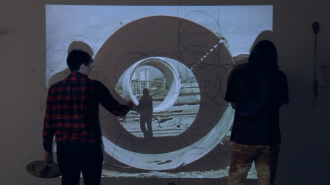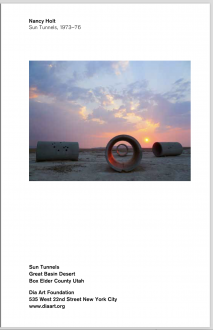Nancy Holt, Sun Tunnels
Great Basin Desert, Utah
Overview
Nancy Holt’s Sun Tunnels (1973–76) is located in the Great Basin Desert in northwestern Utah. Composed of four concrete cylinders that are 18 feet in length and 9 feet in diameter, Sun Tunnels is arranged in an open cross format and aligned to frame the sun on the horizon during the summer and winter solstices. In 2018 Dia Art Foundation acquired Sun Tunnels with support from Holt-Smithson Foundation.
Dia is proud to be the owner and steward of Nancy Holt’s Sun Tunnels. We rely on your help to preserve the artwork for all of us now and for future generations.
Please leave Sun Tunnels and the natural environment exactly as you found it. Visitors must “leave no trace” at the site. Carry out any waste with you. Do not tamper with the artwork, make fire pits, or trample vegetation.
For general inquiries related to Sun Tunnels, contact suntunnels@diaart.org.
Nancy Holt was born in Worcester, Massachusetts, in 1938, and raised in New Jersey. She is internationally recognized for Sun Tunnels (1973–76), a pioneering work of Land art located in Utah’s Great Basin Desert. Holt’s five-decade-long practice included work in art, architecture, and time-based media that involved singular mediations on the environment.
After graduating with a degree in biology in 1960 from Tufts University in Medford, Massachusetts, Holt moved to New York. During these formative years, she traveled extensively to various locations in the United States and abroad and began composing concrete poetry and photographic work that aligned her interest in the nuances of observation and the particularities of site. By the early 1970s, her work became increasingly concerned with the complexities of perception, specifically the effects of light and focus on spatial and temporal conceptions. In 1971 she initiated her multiyear series Locators, consisting of various steel sculptures of vertical rods that support a telescope-like pipe through which a viewer could look. A few years later, she developed the room-sized installations Holes of Light (1973) and Mirrors of Light (1974). Each explores the physical properties of light projected onto cylindrical forms. Holt’s work with artificial light led her to work with natural light in the landscape and, ultimately, create Sun Tunnels.
Holt first visited the American West in 1968. Her engagement with the Western landscape manifested in the photographic series Western Graveyards (1968) and continued with the film Mono Lake (1968/2004), a collaboration with Michael Heizer and Robert Smithson. Holt’s interest in the West as both concept and terrain is evident in her first site-specific environmental work, Missoula Ranch Locators: Vision Encompassed (1972), which placed a series of Locator sculptures within a large field in Montana. In 1973 Holt began working on Sun Tunnels. A year later, she purchased 40 acres in the Great Basin Desert on which she built the work. Sun Tunnels was completed in 1976.
As Holt articulated in 1977: “The idea for Sun Tunnels became clear to me while I was in the desert watching the sun rising and setting, keeping the time of the earth. Sun Tunnels can exist only in that particular place—the work evolved out of its site.” Composed of four concrete cylinders that are 18 feet in length and 9 feet in diameter, Sun Tunnels is arranged in an open cross format and aligned to frame the sun on the horizon during the summer and winter solstices. Each tunnel is perforated by a series of holes corresponding to stars in various constellations—Capricorn, Columba, Draco, and Perseus—so that shadows cast by the sun through these small apertures into each tube trace the earth’s rotation. The work centers Holt’s interest in perception and involves a focus on time—sculpting the sun’s light through the interplay of land and sky, and celestial shifts from day to night.
Dia partners with the Center for Land Use Interpretation, Holt/Smithson Foundation, and the Utah Museum of Fine Arts at the University of Utah to further advocate for Sun Tunnels.
Center for Land Use Interpretation, Wendover, Utah
http://www.clui.org
Holt/Smithson Foundation
www.holtsmithsonfoundation.org
Utah Museum of Fine Arts, University of Utah, Salt Lake City
www.umfa.utah.edu
Photographic and video material of Sun Tunnels is copyright protected. For rights and reproduction requests, contact rights@diaart.org.
Visitor Information
There are no bathrooms, food, fresh water, nor fuel at the site. The nearest locations with bathrooms, drinking water, and gas are in Montello, Nevada, which is approximately 45 minutes from Sun Tunnels. Visitors are advised to bring their own food and water and should be prepared in case of unpredictable weather or automobile occurrences. Phone reception may be unreliable.
Sun Tunnels is an approximate 4-hour drive from Salt Lake City.
- From Salt Lake City, take I-80 west 151 miles through Wendover, Utah, to Oasis, Nevada.
- Take Exit 378 for NV-233 (toward Oasis/Montello). Turn right onto NV-233 E/Montello Rd (toward Montello).
- Continue east for 20 miles (toward Montello). A gas station is located in Montello.
- Continue on NV-233 for 11 miles back into Utah, where the road becomes UT-30.
- About 8 miles past the state line is a sign for Lucin, an empty town with no remaining buildings. There are two gravel roads on the right. Take the first one (Grouse Creek Road) for five miles to Lucin.
- Bear right at the unmarked fork in the road, cross the railroad tracks, and continue on the same road for about 2 miles.
- Turn left onto Little Pigeon Road and proceed about 2 miles. You can see Sun Tunnels in the distance. Turn right following the gravel area for 3/4 mile to Sun Tunnels.
Artist
Nancy Holt
Nancy Holt was born in Worcester, Massachusetts, in 1938. She died in New York in 2014.
Explore


